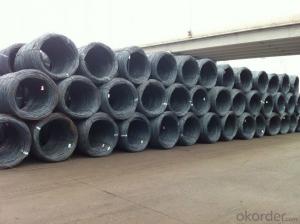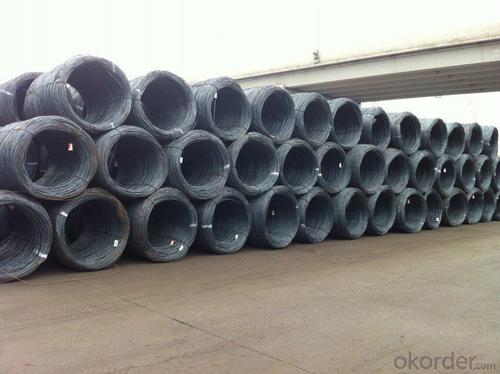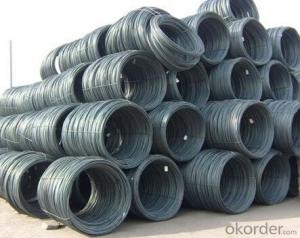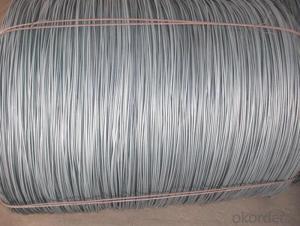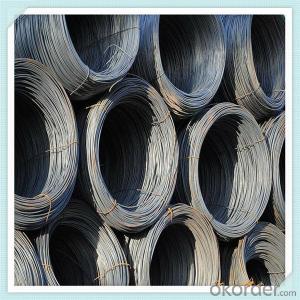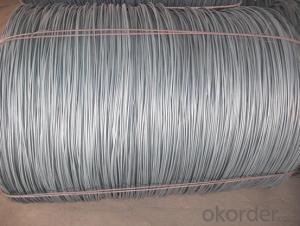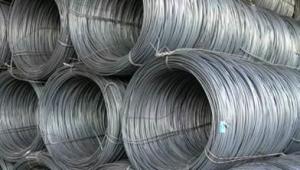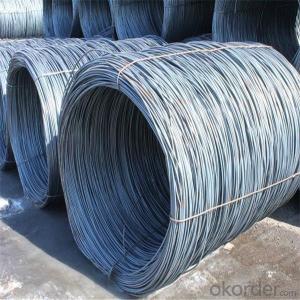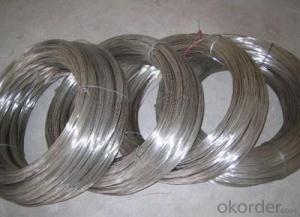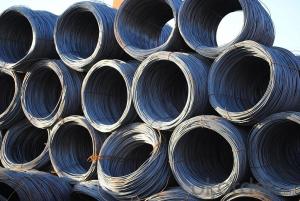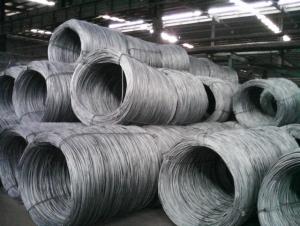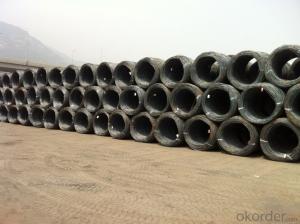Wholesale 5.5-14mm High Carbon Steel Wire Rod
- Loading Port:
- Tianjin
- Payment Terms:
- TT OR LC
- Min Order Qty:
- 25 m.t.
- Supply Capability:
- 5000 m.t./month
OKorder Service Pledge
OKorder Financial Service
You Might Also Like
Specification
Specifications of Steel Wire Rod in Coil:
Steel Grade: Q195/235, SAE1006-1018B Standard: ASTM, GB
Diameter: 5.5mm, 6.5mm, 7mm,8mm,9mm,10mm,12mm,14mm
Type: Drawn Wire Alloy or Not: Alloy Brand Name: HSKY
Technique: Hot Rolled Place of Origin: China Mainland
Chemical Composition:(Please kindly find our chemistry of our material based on SAE1006B and SAE1008B as below for your information)
High carbon/Low carbon/common carbon Steel wire rod | With boron for rebate tax |
Grade | SAE1006B SAE1008B SAE1018B |
Package | In coil ,in bundle, |
Coil weight | about 2000kg-3000kgs |
Size: | 5.5mm 6.5mm 8mm 10mm 12mm 14mm 16mm |
Types | High Carbon ,Low carbon ,Common carbon |
Exported Country | South Korea,Vietnam,Indonesia,Myanmar,Philippines and Afrca,Ect |
Delivery term: | within 30 days after receive the LC |
Payment Term: | LC at sight ,LC 30-120 days after B/L date, TT payment |
The Standard of Physical Properties:
Grade | Chemical Composition(%) | |||||
C | Mn | Si | S | P | Cr | |
SAE1006 | 0.03~O.07 | ≤0.32 | ≤0.30 | ≤0.045 | ≤0.040 | >0.30 |
Mechanical properties | ||||||
Yield strength(N/mm2) | Tensile strength(N/mm2) | Elongation(%) | ||||
250-280 | 350-380 | ≥32 | ||||
Grade | Chemical Composition(%) | |||||
C | Mn | Si | S | P | Cr | |
SAE1008 | 0.10max | 0.3~O.50 | 0.15max | 0.050max | 0.040 max | 0.30 min |
Mechanical properties | ||||||
Yield strength(N/mm2) | Tensile strength(N/mm2) | Elongation(%) | ||||
≥195 | 315-430 | ≥30 | ||||
Usage and Applications of Steel Wire Rod in Coil:
After hot-rolled the products shaped into coil and delivery as finished product, including round, square, rectangular, hexagonal and so on, Since most of the products are round, it is generally called wire rod. Steel wire rod is widely used in construction and manufacturing. Steel wire rod is mainly used for reinforcement of reinforced concrete and welded structure or reprocessed (roberts, nail etc) materials, especially used to produce wire drawing, welding electrode, nails,spring, electronic, precise machinery parts and so on.
Packaging & Delivery of Steel Wire Rod in Coil:
Packaging Detail: products are packed in coil and then shipped by container or bulk vessel
Each coil weight: 2-3MT
Delivery Detail: within 45 days after received deposit or LC.
Label: to be specified by customer, generally, each bundle has 1-2 labels
Trade terms: CFR, CIF

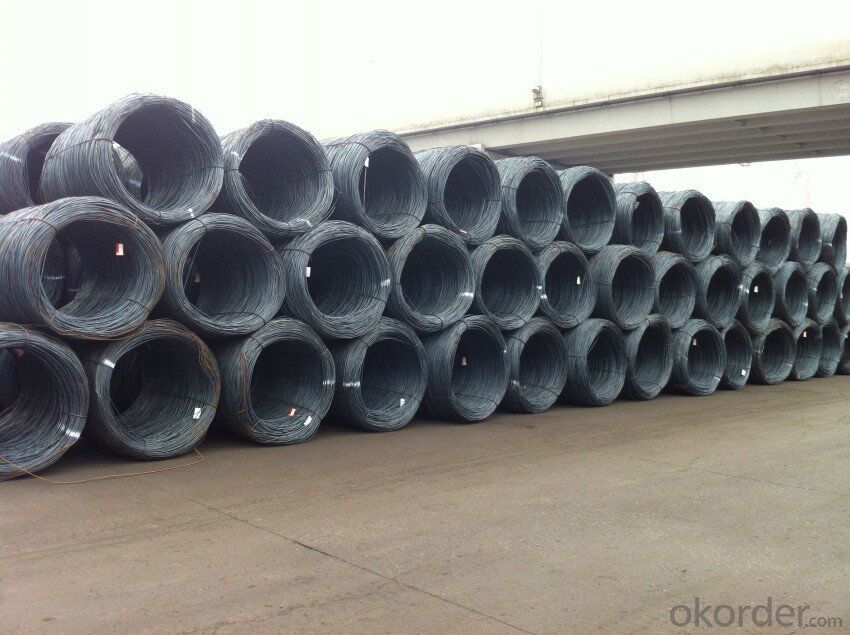
- Q: How is steel wire rod used in the manufacturing of wire forms for wind turbines?
- Steel wire rod is a crucial ingredient in the production process of wire forms used in wind turbines. It acts as the primary material that undergoes several processes to become the final wire forms applied in wind turbine applications. To start with, steel wire rod is chosen for its exceptional strength and durability to endure the harsh environmental conditions and heavy loads encountered by wind turbines. Typically, the wire rod is made of low carbon steel, which offers the desired blend of strength and flexibility. The manufacturing process commences with the wire rod being fed into a wire drawing machine. This machine pulls the wire rod through a sequence of dies, gradually reducing its diameter and increasing its length. This operation, known as wire drawing, enhances the wire's mechanical properties, including tensile strength and surface finish. Once the wire has been drawn to the desired diameter, it is ready for further processing. It may undergo additional treatments like heat treatment or surface coating to enhance its properties. Heat treatment can improve strength and flexibility, while surface coating can provide protection against corrosion and abrasion. After the necessary treatments, the wire is then shaped into the desired form for wind turbine components. This can be accomplished through various methods such as bending, twisting, or welding. These shaping processes are critical in creating wire forms capable of effectively supporting and transmitting the mechanical loads experienced by wind turbines. The wire forms manufactured from steel wire rod find applications in various aspects of wind turbines. They can serve as support structures for the blades, offering stability and strength. Additionally, wire forms are employed as electrical conductors, transmitting power generated by the wind turbine to the electrical grid. In conclusion, steel wire rod plays a vital role in the production of wire forms for wind turbines. Its high strength, durability, and versatility make it an ideal material for withstanding the demanding conditions and loads experienced by wind turbines. Through various processes, the wire rod is transformed into wire forms that act as crucial components in wind turbine construction and operation.
- Q: What are the advantages of using alloyed steel wire rod?
- There are several advantages of using alloyed steel wire rod. Firstly, alloyed steel wire rod offers improved strength and durability compared to regular steel wire rod. This makes it suitable for applications that require high tensile strength and resistance to wear and tear. Additionally, alloyed steel wire rod has better corrosion resistance, making it ideal for use in outdoor or corrosive environments. Furthermore, alloyed steel wire rod can be easily formed and manipulated, allowing for a wide range of applications in various industries such as automotive, construction, and manufacturing. Overall, the use of alloyed steel wire rod provides enhanced mechanical properties, increased longevity, and greater versatility compared to regular steel wire rod.
- Q: What are the advantages of using steel wire rod in oil and gas applications?
- There are several advantages to using steel wire rod in oil and gas applications. Firstly, steel wire rod offers high strength and durability, making it suitable for demanding environments and ensuring reliable performance. Additionally, steel wire rod has excellent corrosion resistance, which is crucial when exposed to harsh conditions and corrosive substances in the oil and gas industry. Furthermore, steel wire rod can be easily fabricated and customized to meet specific requirements, allowing for flexibility in design and application. Lastly, steel wire rod is readily available and cost-effective, making it a practical choice for oil and gas applications.
- Q: How is steel wire rod bundled and packaged for transportation?
- Steel wire rods are bundled and packaged for transportation to ensure their safety and ease of handling. There are several methods commonly used for bundling and packaging steel wire rods. One common method is to bundle the rods together using steel straps or wires. The rods are typically arranged in a neat stack, and the straps or wires are tightly wrapped around the bundle to hold the rods securely in place. This bundling method helps to prevent the rods from shifting or rolling during transportation, reducing the risk of damage. In addition to bundling, steel wire rods are often packaged in wooden crates or pallets for added protection. These crates or pallets provide a sturdy and stable base for the bundled rods, making it easier to lift and move them using forklifts or other handling equipment. The crates or pallets also shield the rods from direct contact with the ground, minimizing the risk of corrosion or other damage. To further protect steel wire rods during transportation, they may be wrapped in plastic or shrink-wrap. This additional layer of packaging helps to shield the rods from moisture, dust, and other contaminants that could potentially cause corrosion or surface damage. Labels and markings are also applied to the bundles and packaging to provide important information about the contents, such as the type and grade of steel, the quantity of rods, and any specific handling instructions. These labels and markings assist in the efficient and accurate identification and handling of the steel wire rods during transportation and storage. Overall, bundling and packaging steel wire rods for transportation involves securing the rods together using steel straps or wires, placing them in wooden crates or pallets, and adding additional protection through plastic or shrink-wrap. This ensures that the rods are well-protected, organized, and easily handled throughout the transportation process.
- Q: What are the different tensile testing methods for steel wire rod?
- Steel wire rods can be evaluated for their mechanical properties using various tensile testing methods. These methods aim to measure characteristics like strength, ductility, and other important factors. Some commonly used methods for testing steel wire rods include: 1. The Standard Tensile Test involves subjecting a sample of the steel wire rod to an increasing load until it breaks. This allows for the calculation of properties like ultimate tensile strength, yield strength, and elongation at fracture. 2. The Charpy Impact Test measures the energy absorbed during the fracture of a notched specimen. It involves striking the sample with a pendulum hammer and recording the absorbed energy. This test is useful for assessing the material's resistance to sudden impact or shock loading. 3. The Bend Test evaluates the material's ductility and resistance to cracking by bending a specimen to a specific angle without fracturing. Any signs of cracking or fracture are noted during this test. 4. The Hardness Test determines the material's resistance to penetration or indentation. Different hardness testing methods, such as Rockwell, Brinell, and Vickers tests, are available. These tests involve applying a known load to the specimen surface and measuring the resulting indentation. Hardness values can be correlated to tensile strength, making this test useful for quality control. 5. The Fatigue Test evaluates the material's endurance limit and fatigue life under repeated cyclic loading. The specimen is subjected to varying loads or stress amplitudes until failure occurs. This test helps determine the material's ability to withstand repetitive loading conditions over time. Overall, these various tensile testing methods provide valuable information about the mechanical properties of steel wire rods. This helps engineers and manufacturers ensure that the material meets the required specifications for its intended applications.
- Q: What are the main factors affecting the market consolidation of steel wire rod?
- The main factors affecting the market consolidation of steel wire rod are the demand-supply dynamics, industry competition, economies of scale, and regulatory factors. The demand for steel wire rod is influenced by the overall economic growth, infrastructure development, and construction activities. The level of competition within the industry, including the number and size of market players, consolidation trends, and pricing strategies, also plays a significant role in market consolidation. Additionally, the ability to achieve economies of scale through efficient production processes and cost optimization is crucial for market consolidation. Lastly, regulatory factors such as trade policies, tariffs, and environmental regulations can impact the market consolidation of steel wire rod.
- Q: What are the dimensions and sizes of steel wire rod?
- The dimensions and sizes of steel wire rod vary depending on the specific application and industry. However, common dimensions range from 5.5mm to 14mm in diameter, with lengths typically ranging from 2,000mm to 3,000mm. Additionally, the specific dimensions and sizes may also vary based on the steel grade and manufacturing standards.
- Q: How is steel wire rod used in the manufacturing of electrical conductors?
- Steel wire rod is used in the manufacturing of electrical conductors as it provides the necessary strength and flexibility required to transmit electricity efficiently. The wire rod is drawn into thin wires which are then insulated and used as the core of electrical cables. These conductors are widely used in power transmission lines, electrical wiring systems, and various electrical appliances to ensure the safe and reliable flow of electricity.
- Q: How is the ductility of steel wire rod evaluated?
- The ductility of steel wire rod is typically evaluated by conducting a tensile test. This test involves subjecting a sample of the steel wire rod to a controlled pulling force until it breaks. During the test, the elongation or deformation of the sample is measured, which gives an indication of the ductility of the material. Ductility is quantified by determining the percentage of elongation or reduction in cross-sectional area before the sample fractures. A higher percentage of elongation or reduction in cross-sectional area indicates greater ductility, while a lower percentage suggests lower ductility. This evaluation method allows manufacturers and engineers to assess the suitability of steel wire rod for various applications, such as in construction, automotive, or manufacturing industries.
- Q: What are the common applications of cold heading quality steel wire rod?
- Cold heading quality steel wire rod is commonly used in the manufacturing industry for various applications such as producing bolts, screws, nuts, and other fasteners. It is also utilized in automotive parts, construction materials, and precision components where high strength and excellent cold forming characteristics are required.
Send your message to us
Wholesale 5.5-14mm High Carbon Steel Wire Rod
- Loading Port:
- Tianjin
- Payment Terms:
- TT OR LC
- Min Order Qty:
- 25 m.t.
- Supply Capability:
- 5000 m.t./month
OKorder Service Pledge
OKorder Financial Service
Similar products
Hot products
Hot Searches
Related keywords
